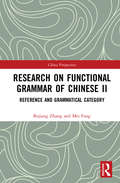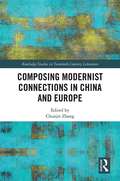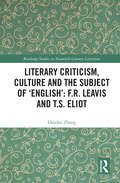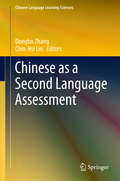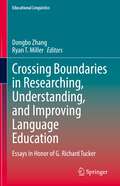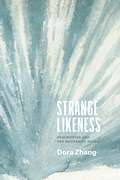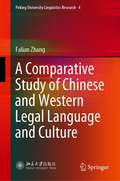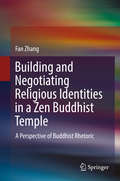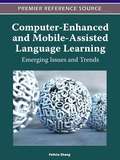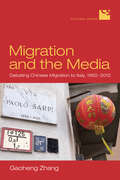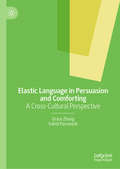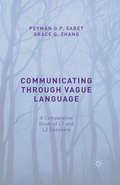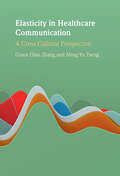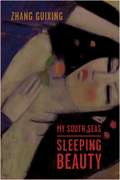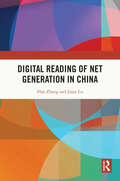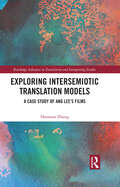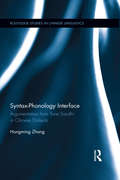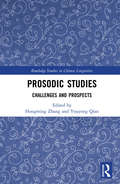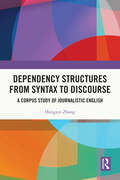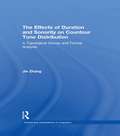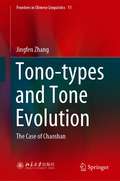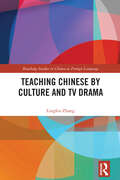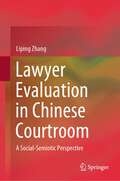- Table View
- List View
Research on Functional Grammar of Chinese II: Reference and Grammatical Category (Chinese Linguistics #2)
by Bojiang Zhang Mei FangThe functional perspective on Chinese syntax has yielded various new achievements since its introduction to Chinese linguistics in the 1980s. This two-volume book is one of the earliest and most influential works to study the Chinese language using functional grammar. With local Beijing vernacular (Pekingese) as a basis, the information structure and focus structure of the Chinese language are systematically examined. By using written works and recordings from Beijingers, the authors discuss topics such as the relationship between word order and focus, and the distinction between normal focus and contrastive focus. In addition, the authors also subject the reference and grammatical categories of the Chinese language to a functional scrutiny while discussion of word classes and their functions creatively combines modern linguistic theories and traditional Chinese linguistic theories. This book will be of interest to students and scholars of Chinese linguistics and linguistics in general.
Composing Modernist Connections in China and Europe (Routledge Studies in Twentieth-Century Literature)
by Chunjie ZhangGlobal modernisms are marked by tremendous transformations in lifestyle, historical consciousness, cultural values, ethics, wars, and crises. This book emphasizes modernist connections within literature, culture, history, and media beyond the nation state and the bifurcation between East and West. Instead of deconstructing and separating, Composing Modernist Connections in China and Europe composes and forges new combinations, linkages, and translations that place Chinese and European modernisms on an equal footing. This book features contributions on James Joyce, Stefan George, Hugo von Hofmannsthal, Anna Seghers, Qian Zhongshu, Weimar labor modernism, Chinese wartime literature, Chinese movies in divided Germany, and Sinophone modernity among other subjects.
Literary Criticism, Culture and the Subject of 'English': F.R. Leavis and T.S. Eliot (Routledge Studies in Twentieth-Century Literature)
by Dandan ZhangThis volume considers the highly convoluted relationship between F. R. Leavis and T. S. Eliot, comparing their ideas in literary and cultural criticism, and connecting it to the broader discourse of English Studies as a university subject that developed in the first half of the twentieth century. Comparing and contrasting all the many writings of Leavis on Eliot, and the two on Lawrence, the study examines how Eliot is formative for the theory and practice of Leavis’s literary criticism in both positive and negative ways, and investigates Lawrence’s significance in relation to Leavis’s changing attitude to Eliot. It also examines how profound differences in social, cultural, religious and national thinking strengthened Leavis’s alliance with Lawrence to the detriment of his relationship with Eliot. These differences between the two writers are presented as dichotomies between nationalism and Europeanism/internationalism, ruralism/organicism and industrialism/metropolitanism, and relate to the two men’s views on literary education, the subject of ‘English’ and the position of the Classics in the curriculum. It explores how Leavis’s increasingly conflicted feelings about a figure to whom he owned an enormous critical debt and inspiration, but whose various beliefs and literary affiliations caused him much misgiving, result in a deep sense of division in Leavis himself which he sought to transfer onto Eliot as what he called a pathological ‘case’.
Chinese as a Second Language Assessment (Chinese Language Learning Sciences)
by Dongbo Zhang Chin-Hsi LinThis book brings together 13 original research papers that address emerging issues in the assessment of Chinese as a Second Language (CSL) in five major areas, including standards in CSL assessment; development of CSL tests; assessment of diverse knowledge and skills; computer-supported assessment; and CSL assessment in relation to instruction and teachers' assessment competence. It goes beyond the psychometric testing of Chinese and provides cutting-edge examinations of the interfaces of assessment with sociology of language, acquisition, pedagogy, and modern technologies, as well as teacher education. Given its unique features and broad range of topics, the book offers an intriguing and valuable resource, not only for scholars and researchers but also teacher educators and assessment practitioners who are directly or indirectly involved in CSL assessment.
Crossing Boundaries in Researching, Understanding, and Improving Language Education: Essays in Honor of G. Richard Tucker (Educational Linguistics #58)
by Dongbo Zhang Ryan T. MillerThis volume brings together original papers from language education scholars from around the world to explore, exemplify, and discuss the multiplicity of boundary crossing in language education. It emphasizes the potential of boundary crossing for expansive learning, and aims to generate new insights, through boundary crossing, into the complexity of language education and approaches to innovative practices. This volume also underscores the important role of expert boundary crossers. In particular, it aims to honor G. Richard Tucker, Paul Mellon University Professor Emeritus of Applied Linguistics at Carnegie Mellon University, celebrating his distinguished scholarship on language education and paying tribute to the inspiration and mentorship he has given to the contributors of this volume to cross boundaries academically and professionally. This volume is organized into four sections, namely, language learning and development; teachers and instructional processes; program innovation, implementation, and evaluation; and language-in-education policy and planning. These sections or themes, which are necessarily cross-cutting, also represent the major areas of scholarship where Prof. Tucker has made distinguished contributions for over half a century.
Strange Likeness: Description and the Modernist Novel (Thinking Literature)
by Dora ZhangThe modern novel, so the story goes, thinks poorly of mere description—what Virginia Woolf called “that ugly, that clumsy, that incongruous tool.” As a result, critics have largely neglected description as a feature of novelistic innovation during the twentieth century. Dora Zhang argues that descriptive practices were in fact a crucial site of attention and experimentation for a number of early modernist writers, centrally Woolf, Henry James, and Marcel Proust. Description is the novelistic technique charged with establishing a common world, but in the early twentieth century, there was little agreement about how a common world could be known and represented. Zhang argues that the protagonists in her study responded by shifting description away from visualizing objects to revealing relations—social, formal, and experiential—between disparate phenomena. In addition to shedding new light on some of the best-known works of modernism, Zhang opens up new ways of thinking about description more broadly. She moves us beyond the classic binary of narrate-or-describe and reinvigorates our thinking about the novel. Strange Likeness will enliven conversations around narrative theory, affect theory, philosophy and literature, and reading practices in the academy.
Strange Likeness: Description and the Modernist Novel (Thinking Literature)
by Dora ZhangThe modern novel, so the story goes, thinks poorly of mere description—what Virginia Woolf called “that ugly, that clumsy, that incongruous tool.” As a result, critics have largely neglected description as a feature of novelistic innovation during the twentieth century. Dora Zhang argues that descriptive practices were in fact a crucial site of attention and experimentation for a number of early modernist writers, centrally Woolf, Henry James, and Marcel Proust. Description is the novelistic technique charged with establishing a common world, but in the early twentieth century, there was little agreement about how a common world could be known and represented. Zhang argues that the protagonists in her study responded by shifting description away from visualizing objects to revealing relations—social, formal, and experiential—between disparate phenomena. In addition to shedding new light on some of the best-known works of modernism, Zhang opens up new ways of thinking about description more broadly. She moves us beyond the classic binary of narrate-or-describe and reinvigorates our thinking about the novel. Strange Likeness will enliven conversations around narrative theory, affect theory, philosophy and literature, and reading practices in the academy.
A Comparative Study of Chinese and Western Legal Language and Culture (Peking University Linguistics Research #4)
by Falian ZhangThis book involves a variety of aspects and levels, including the diachronic and synchronic dimensions. Law profoundly affects our daily lives, but its language and culture can at times be nearly impossible to understand. As a comparative study of Chinese and Western legal language and legal culture, this book investigates the similarities and differences of both sides and identifies their respective advantages and disadvantages. Accordingly, it considers both social and cultural functions, and both theoretical and practical values.Firstly, the book addresses the differences, that is, the basic frameworks and disparities between the Chinese and Western legal languages and legal cultures. Secondly, it explores relevant changes over time, that is, the historical evolution and the basic driving forces that were at work before the Chinese and Western legal languages and cultures “met.” Lastly, the book elaborates on their fusion, that is, the conflicts and changes in Chinese and Western legal languages and cultures in China in the modern era, as well as the introduction, transplantation and transformation of Western legal culture.
Building and Negotiating Religious Identities in a Zen Buddhist Temple: A Perspective of Buddhist Rhetoric
by Fan ZhangThis book explores the practices in a Zen Buddhist temple located in Northwest Ohio against the backdrop of globalization. Drawing on the previous studies on Buddhist modernization and westernization, it provides a better understanding of the westernization of Buddhism and its adapted practices and rituals in the host culture. Using rhetorical criticism methodology, the author approaches this temple as an embodiment of Buddhist rhetoric with both discursive and non-discursive expressions within the discourses of modernity. By analyzing the rhetorical practices at the temple through abbots’ teaching videos, the temple website, members’ dharma names, and the materiality of the temple space and artifacts, the author discovers how Buddhist rhetoric functions to constitute and negotiate the religious identities of the community members through its various rituals and activities. At the same time, the author examines how the temple’s space and settings facilitate the collective the formation and preservation of the Buddhist identity. Through a nuanced discussion of Buddhist rhetoric, this book illuminates a new rhetorical methodology to understand religious identity construction. Furthermore, it offers deeper insights into the future development of modern Buddhism, which are also applicable to Buddhist practitioners and other major world religions.
Computer-Enhanced and Mobile-Assisted Language Learning: Emerging Issues and Trends
by Felicia ZhangAs the field of Information and Communication Technologies rapidly expands, the applications to language learning continue to grow. Computer-Enhanced and Mobile-Assisted Language Learning: Emerging Issues and Trends compiles the latest research into computer-enhanced language learning, as well as the integration of mobile devices into new language acquisition. Though new information is constantly coming out as technologies continue to evolve, this important new follow-up publication will be distributed worldwide among academic and professional institutions and will be instrumental in providing researchers, scholars, students, and professionals access to the latest knowledge related to research on computer-enhanced and mobile assisted language learning.
Migration and the Media: Debating Chinese Migration to Italy, 1992–2012 (Cultural Spaces)
by Gaoheng ZhangThe first book to analyze cultural dynamics of Chinese migration to Italy between 1992 and 2012, Migration and the Media compares Italian, Chinese migrant, and international media interpretations. During this twenty-year period, the media covered this migration extensively, revealing the eye-opening characteristics of Italy’s Chinese community. Gaoheng Zhang places the strong media interest in Italian-Chinese migrant relations within relevant economic, political, cultural, and linguistic contexts. Examining how journalists, entrepreneurs, and politicians debated Italy’s Chinese, Zhang argues that these stakeholders viewed the migration as a particularly effective example to support or dispute Italy’s general stance toward migrant integration and economic globalization. Zhang also proposes that an Italian-Chinese migrant cultural repertoire offered the stakeholders resources to cover the migration.
Elastic Language in Persuasion and Comforting: A Cross-Cultural Perspective
by Grace Zhang Vahid ParvareshThis innovative book examines the discourse of reality television, and the elasticity of language in the popular talent show The Voice from a cross-cultural perspective. Analysing how and why elastic language is used in persuasion and comforting, a comparison between Chinese and English is made, and the authors highlight the special role that elastic language plays in effective interactions and strategic communication. Through the lens of the language variance of two of the world’s most commonly spoken languages, the insights and resources provided by this book are expected to advance knowledge in the fields of contrastive pragmatics and cross-cultural communication, and inform strategies in bridging different cultures. This study highlights the need to give the elastic use of language the attention it deserves, and reveals how language is non-discrete and strategically stretchable. This book will be of interest to academics and postgraduate students engaged in elastic/vague language studies, cross-cultural pragmatics, media linguistics, discourse analysis, sociolinguistics and communication studies.
Elastic Language
by Grace Q. ZhangElastic language carries non-specific and stretchable meaning, as in 'He loves her, kind of'. It is used like a slingshot, targeting various strategic goals. Consolidating current research and charting new directions, this book develops a refreshing theory of elasticity, empirically attested by natural language data from tension-prone encounters between Australian Customs officers and passengers. The theory proposes three principles (fluidity, stretchability and strategy) and offers a systematic look at how elastic language, as a sliding scale, works to balance strengthening and weakening speech tones, to firm and soften a speaker's stance, and to reveal and evade the truth. The comparative analysis of forms, functions, and context confirms that elastic language is fluid, stretchable, and strategic. It serves both cooperative and competitive functions, and social and speech factors impact on its use. This book will appeal to students and researchers working in pragmatics, applied linguistics, sociolinguistics, discourse analysis, and communication.
Communicating through Vague Language: A Comparative Study of L1 and L2 Speakers
by Grace Q. Zhang Peyman G.P. SabetThis book is a comparative study of vague language based on naturally occurring data of L1 and L2 speakers in academic settings. It explores how L2 learners have diverse and culturally specific needs for vague language compared with L1s, and are generally vaguer.
Elasticity in Healthcare Communication: A Cross-Cultural Perspective
by Grace Qiao Zhang Ming-Yu TsengElastic language is a phenomenon in linguistics that refers to how we stretch the meanings of words, depending on the context in which they are used – for example many, about 20, perhaps, could be. This study looks specifically at elastic language in the fields of medicine and healthcare, showing how it is used to serve both the patient's and the professional's needs. It explores the pragmatics and metapragmatics of elasticity in the delivery of online medical information as a way of avoiding miscommunication. Based on data from Chinese and English sources, it takes a cross-cultural perspective, to present an account of harmony and disharmony between professional medical websites and their users. Adding exciting new dimensions to the fields of health communication and pragmatics, it is essential reading for scholars and advanced students in semantics, pragmatics, discourse analysis and interactional linguistics, as well as professionals involved in healthcare and communication.
My South Seas Sleeping Beauty: A Tale of Memory and Longing (Modern Chinese Literature from Taiwan)
by Guixing ZhangMy South Seas Sleeping Beauty is a captivating coming-of-age tale set in the magical jungles of Borneo. Told through the vivid recollections of a Chinese-Malay youth, the novel recounts the life of Su Qi, a troubled, sensitive son of a wealthy family, and exemplifies the imaginative range of one of Taiwan's most innovative writers. "There were all sorts of stories about how my younger sister died," Su Qi begins, hinting at the power of memory to bend and refract truth. Yet whichever the real story may be, the fact is that the death of Su Qi's sister created an irrevocable rift in Su Qi's family, driving his father into the arms of aboriginal women and his mother into a world of her own invention. In an effort to escape the oppression of home, Su Qi loses himself in the surrounding jungle, full of Communist guerillas and strange tropical fauna. The jungle further blurs the line between fantasy and reality for Su Qi, until he meets Chunxi, the beautiful, frail daughter of his father's best friend. Chunxi is an oasis of kindness and honesty in an otherwise cruel and evasive world, but after a bizarre accident, Chunxi falls into a deep coma, and Su Qui flees to Taiwan. In college Su Qi meets Keyi, a vivacious siren who helps Su Qi forget not only his violent past but also the colorful tales of his youth. When a family member dies, however, Su Qi is pulled back to the jungles of Borneo where he begins to unravel the secrets of his family's past-a story stranger than any fairy tale-and learns that his cherished dream of awakening his beloved Chunxi may be more than just a fantasy. Influenced by the lyricism of William Faulkner and the magical realism of Gabriel Garcia Marquez, My South Seas Sleeping Beauty is a deeply evocative exploration of sexuality and identity and a masterful reworking of Chinese and Western myth. Valerie Jaffee's careful translation retains all the tone and detail of the original work and provides rare access to a new and exciting generation of Chinese writers born in Southeast Asia.
Digital Reading of Net Generation in China
by Han ZHANG Jiajie LUWith the methodology of eye-tracking experiments, in-depth interviews and large-scale questionnaires across cities, this book provides a panoramic vision of digital reading and social interaction among the new generations in China. Growing up under the background of social transformation, cultural integration and technological progress, digital reading of the Chinese net generation presents complex characteristics. People born in the 1980s and 90s are better educated, have democratic consciousness, and have strong motivations for self-expression. Meanwhile, reading behaviours affect their content production, virtual identities, and socialization in the real world. The immense need for digital content fuels the digital reading industries. Internet literature, social media articles, reading APPs and e-reader devices have also benefited from media content and interface innovation in the market. This book provides a solid scientific foundation for reading promotion and guiding strategies in the context of digital media and offers empirical evidence for policy formulation of reading promotion and spiritual civilization in the digital age. The authors expand the perspective of communication studies on digital reading and analyze how the youth reads on digital devices and creates content for interest or profit. The book will be a great read for students and scholars of mass communication, media studies and digital publishing.
Exploring Intersemiotic Translation Models: A Case Study of Ang Lee's Films (Routledge Advances in Translation and Interpreting Studies)
by Haoxuan ZhangThis volume sets out a new paradigm in intersemiotic translation research, drawing on the films of Ang Lee to problematize the notion of films as the simple binary of transmission between the verbal and non-verbal. The book surveys existing research as a jumping-off point from which to consider the role of audiovisual dimensions, going beyond the focus on the verbal as understood in Jakobsonian intersemiotic translation. The volume outlines a methodology comprising a system of various models which draw on both translation studies and film studies frameworks, with each model illustrated with examples from Ang Lee’s Crouching Tiger, Hidden Dragon; Lust, Caution; and Life of Pi. In situating the discussion within the work of a director whose own work straddles East and West and remediates between cultures and semiotic systems, Zhang argues for an understanding of intersemiotic translation in which films are not simply determined by verbal source material but through the process of intersemiotic translators mediating non-verbal, quality-determining materials into the final film. The volume looks ahead to implications for translation and film research more broadly as well as other audiovisual media. This book will appeal to scholars interested in translation studies, film studies, media studies and cultural studies in general.
Syntax-Phonology Interface: Argumentation from Tone Sandhi in Chinese Dialects (Routledge Studies in Chinese Linguistics)
by Hongming ZhangThis book centers on theoretical issues of phonology-syntax interface based on tone sandhi in Chinese dialects. It uses patterns in tone sandhi to study how speech should be divided into domains of various sizes or levels. Tone sandhi refers to tonal changes that occur to a sequence of adjacent syllables or words. The size of this sequence (or the domain) is determined by various factors, in particular the syntactic structure of the words and the original tones of the words. Chinese dialects offer a rich body of data on tone sandhi, and hence great evidence for examining the phonology-syntax interface, and for examining the resulting levels of domains (the prosodic hierarchy). Syntax-Phonology Interface: Argumentation from Tone Sandhi in Chinese Dialects is an extremely valuable text for graduate students and scholars in the fields of linguistics and Chinese.
Prosodic Studies: Challenges and Prospects (Routledge Studies in Chinese Linguistics)
by Hongming Zhang Youyong QianProsody is one of the core components of language and speech, indicating information about syntax, turn-taking in conversation, types of utterances, such as questions or statements, as well as speakers' attitudes and feelings. This edited volume takes studies in prosody on Asian languages as well as examples from other languages. It brings together the most recent research in the field and also charts the influence on such diverse fields as multimedia communication and SLA. Intended for a wide audience of linguists that includes neighbouring disciplines such as computational sciences, psycholinguists, and specialists in language acquisition, Prosodic Studies is also ideal for scholars and researchers working in intonation who want a complement of information on specifics.
Dependency Structures from Syntax to Discourse: A Corpus Study of Journalistic English
by Hongxin ZHANGBased on the large corpora of journalistic English, this title examines dependency relations and related properties at both syntactic and discourse levels, seeking to unravel the language patterns of real-life usage. With a focus on rank-frequency distribution, the author investigates the distribution of linguistic properties/units from the perspectives of properties, motifs and sequencings. At the syntactic level, the book analyses the following three dimensions: various combinations of a complete dependency structure, valency and dependency distance. At the discourse level, it proves that the elements can also form dependency relations by exploring (1) the rank-frequency distribution of Rhetorical Structure Theory relations, their motifs, discourse valency and discourse dependency distance; (2) whether there is top-down organisation or an inverted pyramid structure at all the three discourse levels; and (3) whether discourse dependency distances and valencies are lawfully distributed, following the same distribution patterns as those at the syntactic level. This book will be of great value for scholars and students of quantitative linguistics and computational linguistics and its practical insights will also benefit professionals of language teaching and journalistic writing.
The Effects of Duration and Sonority on Countour Tone Distribution: A Typological Survey and Formal Analysis (Outstanding Dissertations in Linguistics)
by Jie ZhangFirst Published in 2002. Part of the Outstanding Dissertations in Linguistics series, this is an in-depth investigation of the effects of duration and sonority on contour tone distribution. The term “tone language” usually refers to languages in which the pitch of a syllable serves lexical or grammatical functions. In some tone languages, the contrastive functions of pitch are sometimes played by pitch changes within a syllable. Pitch changes of this kind are called contour tones. The distribution of contour tones in a language, are when under what phonological contexts contour tones are more readily realized.
Tono-types and Tone Evolution: The Case of Chaoshan (Frontiers in Chinese Linguistics #11)
by Jingfen ZhangThis book is a comprehensive study on the phonetic characteristics of citation tones in Chaoshan Chinese. It presents the tonal patterns of 65 localities in the Chaoshan area under the “multiple-register and four-level” tonal model. Three case studies are conducted to delve into the evolutionary paths of Chaoshan tones. This book not only provides a large-scale typological study on Chaoshan Chinese, but also offers a good example of how to figure out the evolutionary paths of tones from the perspective of variation. The natural alliance of phonetics, historical linguistics, sociolinguistics, and dialect geography is reinforced. It is also suggested in this book that the joint use of these four disciplines is very promising for the study of Chinese.
Teaching Chinese by Culture and TV Drama (Routledge Studies in Chinese as a Foreign Language)
by Lingfen ZhangThis book integrates culture and authenticity into Chinese classroom practice through exploring the potential of contemporary TV drama as teaching and learning materials for intercultural Chinese language teaching and learning. In addressing the four main challenges in culture teaching in Teaching Chinese as a Foreign Language (TCFL), this book focuses on precisely this area of pedagogical practice in Chinese as foreign language education and draws on a wide interdisciplinary base, including foreign language education, cultural studies, and intercultural communication to explore the potential of authentic TV drama as language and culture materials for revitalising TCFL and foreign language teaching more generally. It examines in detail the culturally shaped beliefs, values, and practices that give meaning to the action and language of the selected clips in a modern, award-winning Chinese TV drama. This book shows a potential experiential pathway into (pedagogical) practices to bring contemporary culture into classrooms, to engage learners with contemporary and authentic texts, and to encourage inquiry-focused teaching practices, which – in being intercultural – allow for learners’ own interpretations of cultural messages in interaction and to recognise learners as learning to understand their own values and beliefs as they learn to explore those of other cultures.
Lawyer Evaluation in Chinese Courtroom: A Social-Semiotic Perspective
by Liping ZhangThis book focuses on the speech style of lawyer talk in contemporary Chinese courtrooms. The topic is intriguing to readers who may wonder how lawyers compete with their opposing counterparts in an adversarial trial system in China. The legal tradition in Confucianism, which advocates harmony in interpersonal relationships, has historically guided the practice of law in China. The book analyses how lawyers manage to compete in this system. Applying the social semiotic view of language in the Hallidayian sense, specifically systemic functional linguistics and its appraisal theory, this study interprets the subjectivity of legal language by lawyers. The speech style in legal argument presentation is described as 'rational'. The exploration of the rational speech style of lawyers is a theoretical and discursive topic. It draws upon Habermasian philosophy of intersubjectivity in legal argumentation and considers the cultural and legal contexts of China as contextual constraints. The keyconstruct of lawyer evaluation is fully captured in this discussion. As a linguistic phenomenon and unit of analysis, discourse can be examined both within local clauses and in larger stretches of talk beyond clauses. Additionally, it serves as an effective means for constructing a rational speech style for lawyers. Most importantly, discourse is a discursive act that negotiates legal arguments in the dynamic speech exchanges of a court trial, which is embedded in a wider social and cultural context. The book showcases instances of lawyer talk in well-documented trials in China and offers a good opportunity for readers to gain a general understanding of courtroom discourse in the Chinese context. It introduces readers with special interests in legal language and the law to the solidarity dimension of legal language and arguments, an alternative to the confrontational or hostile lawyer talk in trials in countries with a common-law system. The analysis presented is refined and the language used is clear, concise, and objective.
